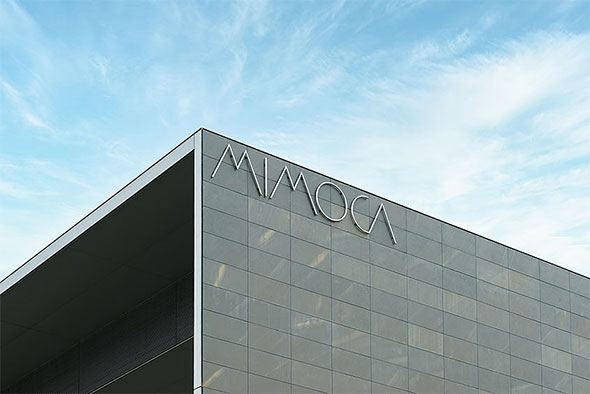A museum opened towards the city MIMOCA
Marugame Genichiro-Inokuma Museum of Contemporary Art
Sophie Richard wanders around Japan
Words by Sophie Richard

A museum opened towards the city MIMOCA
Marugame Genichiro-Inokuma Museum of Contemporary Art
It is impossible to miss the MIMOCA when in Marugame, a city located on the island of Shikoku. With its location at the heart of the city’s central plaza and its close proximity to the train station, MIMOCA is a resolutely urban museum. And its façade is unmistakable: it appears like a series of interpenetrating concrete boxes, whose vast outer walls frame and shelter large outdoor sculptures in bold primary colours and a sizeable mural.

This distinctive building, characterised by a strong visual presence and generous volumes, is the work of Taniguchi Yoshio who has designed many significant art museums during his long career. For this particular project, the architect was in dialogue with Inokuma Genichiro, the artist the museum is dedicated to.
Born in Shikoku, Inokuma (1902-1993) spent his youth in Marugame and the city founded a museum in his name in 1991. The institution is home to some 20,000 of Inokuma’s works, donated by the artist himself and that span his entire career, during which he spent time in Tokyo, Paris, New York and Hawaii. The museum’s rich collection allows for a survey of his life not only through his artworks but also the objects he collected, antiques and everyday items. Inokuma’s style evolved throughout the years as he was in touch with the spirit of the time and the places he lived in. Wishing for spacious galleries that would allow his works to breathe, Inokuma exchanged at length with Taniguchi about the architecture and design of the museum.
Visitors are greeted before the entrance by Inokuma’s large sculptures and mural already mentioned. Inside, the ground floor is occupied by the Entrance Hall and the Museum Shop while above there are two levels with galleries of contrasting sizes. Adding to the abundant sense of space are the wide staircase that affords views between the levels, a generous amount of natural light, and on the top floor a view of the city framed by a long horizontal window. The last gallery opens onto an open courtyard called Cascade Plaza and which includes a water feature and outdoor sculptures. A broad and grand staircase is placed to one side of the building and opened towards the city below, taking visitors back to the ground level. While walking down, they can admire the cityscape in the distance and the play of light against the concrete walls around them.


MIMOCA holds three to four exhibitions a year, with at least one of them dedicated to Inokuma and an aspect of his lengthy career. But the latter did not wish for MIMOCA to be a memorial museum: famously open-minded, he wanted the work of other artists to also feature in the museum. Therefore, there are themed exhibitions focusing on Japanese or international contemporary art.


Two anecdotes related to me by a curator give an indication of how personal this museum project was for Inokuma. Past the entrance, I observed a tall silicon column in which a wooden sandal, or geta, appears to be floating. This installation is a reminder of a dramatic incident of Inokuma’s childhood during which he almost drowned in a river, losing his geta. Luckily, he was rescued by an old man who subsequently found the geta and returned it to him. This episode happened in Marugame, which might explain why Inokuma chose the city, where his life was saved, for his museum. Besides, in his discussions about it, he insisted on the museum presenting a feeling of openness and approachability. Based on Inokuma's experiences in New York, he wished for MIMOCA to become a place where citizens casually stop by, with shopping bags in hand, just like in New York. The museum’s proximity to the train station ensures it is indeed very accessible, and Taniguchi’s striking design is sure to attract all passers-by. My visit allowed me to appreciate the vision of the artist and that of the architect and how successfully they met at MIMOCA.
For those who enjoy architecture and design, there are more enticing places to see in the area, among them the Shikoku Mura Museum where several historical buildings from the Edo through to the Taisho periods have been preserved, and the Isamu Noguchi Garden Museum.

Marugame Genichiro-Inokuma Museum of Contemporary Art (MIMOCA)
- Place
- 80-1 Hama-machi, Marugame-shi, Kagawa 763-0022 JAPAN
- Time
- 17 June - 18 September 2023
8 October 2023 - 10 December 2023
23 December 2023 - 10 March 2024
10:00-18:00 (No admittance after 17:30) - Closed
- Closed on Mondays, and from December 25 to 31 and occasionally on other days during the changing of exhibitions.

